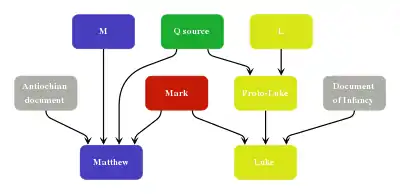L source
In historical-critical analysis, the L source is an hypothetical oral tradition which Luke may have used when composing his gospel.[1][2] It includes the virgin birth of Jesus and many of Jesus' best loved parables. Like Matthew's unique source, known as M, the L source has important parables.[1] Two which appear in L are the Good Samaritan and the Prodigal Son.[1] I. Howard Marshall states "Luke rightly regarded these sources as reliable".[3]

According to the four-document hypothesis, Luke combined Mark, the Q source, and L to produce his gospel.[1] The material in L, like that in M, probably comes from the oral tradition.[1] Luke's special material composes nearly half of his gospel.[4]
The question of how to explain the similarities among the Gospels Matthew, Mark, and Luke is known as the synoptic problem. The hypothetical L source fits a contemporary solution in which Mark was the first gospel and Q was a written source for both Matthew and Luke.
James R. Edwards equates the L Source with the Hebrew Gospel referred to by patristic authors.[5] His thesis has not been accepted by other scholars.[6][7][8]
See also
References
- Funk, Robert Walter; Hoover, Roy W.; Jesus Seminar (1993). "Introduction". The Five Gospels: The Search for the Authentic Words of Jesus. New Translation and Commentary. HarperSanFrancisco. pp. 1–30. ISBN 978-0-02-541949-0.
- Jones, Brice (2011). Matthean and Lukan Special Material: A Brief Introduction with Texts in Greek and English. Wipf and Stock Publishers. ISBN 978-1-61097-737-1.
- Marshall, I. Howard (1994). "LUKE. Introduction". In Carson, D. A.; et al. (eds.). New Bible Commentary: 21st Century Edition. Inter-Varsity Press. p. 979. ISBN 978-0-85110-648-9.
- Theissen, Gerd; Merz, Annette (1998). "Chapter 2. Christian sources about Jesus.". The Historical Jesus: A Comprehensive Guide. Translated from German (1996 edition). Fortress Press. ISBN 978-0-8006-3123-9.
- Edwards, James (2009). The Hebrew Gospel and the development of the synoptic tradition. Grand Rapids, Michigan: Eerdmans. ISBN 0-8028-6234-9. OCLC 368048433.
- Friedrichsen, Timothy A. (2010). "Book review: The Hebrew Gospel and the Development of the Synoptic Tradition" (PDF). Review of Biblical Literature.
- Sweeney, James P. (2010). "Book review: The Hebrew Gospel and the Development of the Synoptic Tradition" (PDF). Review of Biblical Literature.
- Kloppenborg, John S. (2011-04-14). "The Hebrew Gospel and the Development of the Synoptic Tradition (review)". Toronto Journal of Theology. 27 (1): 109–111. doi:10.1353/tjt.2011.0000. ISSN 1918-6371.